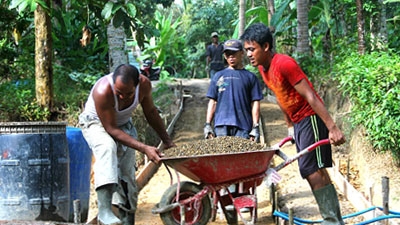Communities design development agenda to solve their problems
By focusing primarily on the process by which local development projects are planned and managed, rather than on what gets built, PNPM Mandiri marks a sharp departure from the traditional framework of inflexible large development projects.
The objective of PNPM Mandiri is to have the communities design and approve their development agenda. By directly involving communities in decision-making, the program’s participatory and transparent framework is also helping improve local governance. Communities are able to propose activities based on what they most need, and tailored to their context to solve their problems.
In Majalengka Regency, West Java Province, the building of the Pasirhanja irrigation channel completed in December 2010 immediately put an end to the conflict among the farmers in Pasirhanja, because water now flows evenly in the upstream and downstream areas, providing everyone an adequate share of water for their rice fields. The farmers now benefit from being able to plant two or three rice crops per year because water is now available even during the dry season. Production is now expected to rise from 210 tons to 315 tons of unhulled rice.
The program’s approach allows innovations
The PNPM platform also allows local governments and facilitators to innovate when providing services to their communities. With close cooperation with the local Health Office, PNPM Generasi in Larantuka, Flores Timur District, Nusa Tenggara Timur, has successfully decreased maternal deaths from 14 to 5. The District Health Office set up what they call a 2H2 Center program, consisting of a simple computer and a mobile-phone based information system that provide data of all pregnant mothers in the district. The data allows them to provide an estimated delivery date and to coordinate the monitoring of the mothers’ condition with local religious leaders. Innovation can indeed save lives.
“We want to make sure that no mother is alone during delivery”, says Joria Parmin, a Midwife Coordinator at Flores Timur District’s Health Office. Close to the delivery period, these mothers are brought to the provided Puskesmas facility, and in complicated cases, they are referred to the nearest hospital, which often are quite far. Effective coordination with the referral hospital can mean life and death. Time is saved by ensuring that once a pregnant mother is on the way to the hospital, an ambulance is deployed to a pick-up point.
The success of PNPM has piqued the interest of many countries. Last April 2012, a delegation from Afghanistan’s National Solidarity Programme visited a PNPM site in Yogyakarta. Not only was he impressed by the quality of low-budget infrastructures that the communities built, delegation member Abdul Rahman said that he was inspired by the program. “I see the integrated approach -PNPM urban, rural and the other supporting activities based on sector, region and special needs of communities- as very useful. To me, it is excellent because the needs vary and one program cannot do everything. However, the challenge in such integration is the effective coordination and synergies on how these sub-sets can complement each other and achieve the overall objective,” he said.
These achievements are not without challenges. Some areas still experience lack of support from local governments. PNPM has also not been very effective in reaching the marginalized groups, and local elite domination still exist within decision making. But such challenges often encourage the communities and their supporters to strive for solutions. Five years on, PNPM has become an integral part of communities across Indonesia, and these communities are committed to transforming their dreams into reality.

